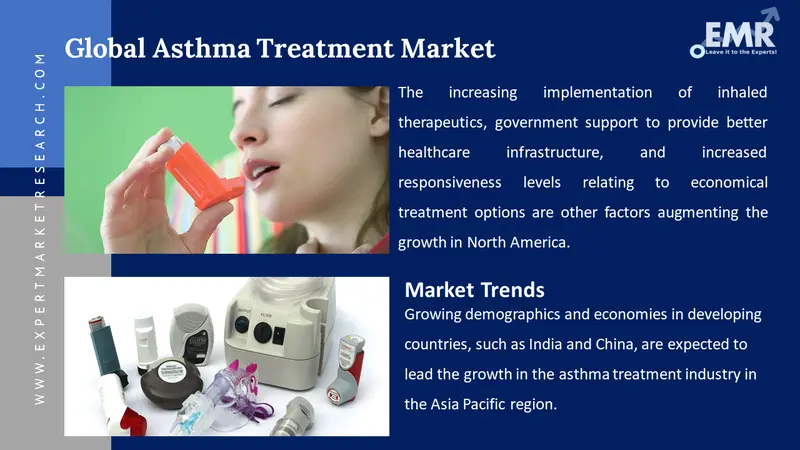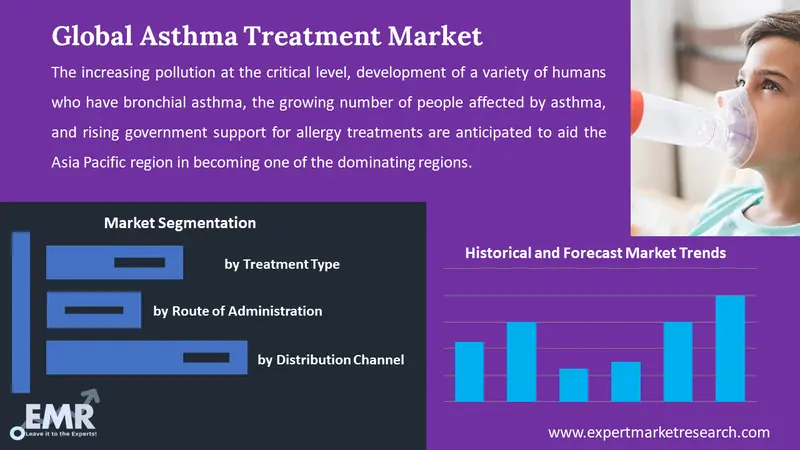
Consumer Insights
Uncover trends and behaviors shaping consumer choices today
Procurement Insights
Optimize your sourcing strategy with key market data
Industry Stats
Stay ahead with the latest trends and market analysis.
The global asthma treatment market size attained a value of USD 20.42 Billion in 2025. The market is likely to grow further at CAGR of 4.60% during the forecast period of 2026-2035 to reach a value of nearly USD 32.02 Billion by 2035, driven by the rising prevalence of asthma triggered by the poor air quality index.
Base Year
Historical Period
Forecast Period
Compound Annual Growth Rate
4.6%
Value in USD Billion
2026-2035
*this image is indicative*
Asthma is a respiratory disease in which it becomes hard for an individual to breathe due to inflammation in lungs. In this condition, the airways contract and swell, producing excess mucus and resulting in shortness of breath, cough, and wheezing. Asthma happens due to a combination of environmental and genetic factors, or either of the two. Exposure to different irritants and substances like smoke, dust, cold, stress, and certain medications, like aspirin and non-steroidal anti-inflammatory drugs, might light to asthma.
The indication and symptoms of the disease can vary from person to person. An individual may have rare asthma attacks anywhere and at any time. They can experience symptoms while working out or while running and might require immediate help. Asthma symptoms include chest pain, wheezing, shortness of breath, and trouble sleeping due to cough. All these symptoms further worsen the respiratory health.

Read more about this report - REQUEST FREE SAMPLE COPY IN PDF
The diagnosis of asthma depends on the severity of the disease. Based on the symptoms, the doctor may ask for various tests, like allergen tests, skin tests, and imaging tests, to determine the cause of asthma. In case of a severe condition, the doctor may ask for a spirometry test that measures the airflow through the lungs and is used to diagnose and monitor the treatment progress.
Prohibition and long-term control are the only two ways that can prevent asthma attacks to some extent. The treatment procedure for asthma patients also depends on their age and the severity of the symptoms. Long-term asthma drugs are the most relied upon asthma treatment. These drugs keep asthma under control on daily basis, which can reduce the cases of asthma attacks as well. A variety of long-term control drugs include Leukotriene modifiers, Inhaled corticosteroids, Theophylline, and Combination inhalers.
Quick-relief drugs are required for immediate and short-term relief during an asthma attack. A variety of quick-relief medicines include oral and intravenous corticosteroids, Anticholinergic agents, and short-acting beta-agonists. If a person is having an asthma attack, a quick-relief treatment can ease their symptoms immediately, providing relief. But a person should not use a quick-relief inhaler often if the long-term drugs are working correctly, as it might affect the overall treatment.
The cases of asthma treatment are constantly rising as there has been a rapid rise in airborne pollens, triggered by the rising air pollution. Deteriorating climate health and excessive use of antibiotics has significantly contributed to the rising number of asthma patients.
The Centers for Disease Control and Prevention (CDC) published instructions and urged more precautions for asthma patients during the 2019-2020 coronavirus pandemic. This was because asthma patients were more vulnerable to the fatalities of the virus. This triggered the demand for treatment medications to reduce the number of deaths, adding to the growing demand for the medications.

Read more about this report - REQUEST FREE SAMPLE COPY IN PDF
According to the asthma treatment market research report, the market can be categorised into the following segments:
Market Breakup by Diagnosis Method
Market Breakup by Treatment Method
Market Breakup by Type
Market Breakup by Product Type
Market Breakup by Age
Market Breakup by Distribution Channels
Market Breakup by Treatment Channel
Market Breakup by Region
Asthma is prevalent globally because of the rise in tobacco consumption and increase in smoking. These two factors are driving the growth of the asthma treatment market. The increase in air pollution and the prevalence of indoor and outdoor allergens will further add to the number of asthma. The increase in exposure to toxic substances in the laboratory will lead to a rising populace suffering from asthma treatment.
North America is accounting highest incidence of asthma treatment worldwide. The Europe market is witnessing consistent development in the pharma industry and asthma-related therapeutics. Asia Pacific, on the other hand, is estimated to prevail highest growth rate for the estimated period. This leads to increase in global asthma treatment cost market. The awareness about different novel treatments and drugs within the communities will drive the asthma treatment market.
Numerous drugs are used to treat asthma disorders, known as asthma therapies. Asthma is triggered by indoor and outdoor factors, such as dust, pollution, and allergens. Bronchodilators and anti-inflammatory medicines, such as immunomodulators, long-acting beta-agonists (LABA), corticosteroids, methylxanthine, and leukotriene modifiers, are commonly used as medication.
The recent scientific investigation has given clinicians the devices for considerably updating the standard of care within the field of bronchial asthma. It implies decreasing steroid-related morbidity, particularly for severe asthma, and most importantly, improving the patient's lifestyle. The recent challenge is to fill the gap between the enormous potential and its execution in day-to-day clinical practice.
Depending upon the symptoms, the following drugs may be prescribed by the physicians based on the diagnosis:
Several combinations treatment drugs are used, which can be taken orally, injected, or inhaled. These medications expand the pathway into the lungs and permit airflow, improving breathing. They help in eliminating mucus from the lungs, which is easy to cough out. One of the primary reasons driving the asthma treatment market growth is the rising prevalence of asthma and other respiratory ailments and advancements in diagnostic technology.
Furthermore, rising public awareness about the availability of effective asthma drugs and treatment is driving the asthma treatment market growth. For example, inhaled corticosteroids are used to treat asthmatic individuals, whereas target-specific medications are used to treat patients with advanced diseases or chronic asthma.
Monoclonal antibodies (mAbs) that inhibit immunoglobulin E and particular cytokines are also in high demand because they are an effective way to treat chronic asthma that is not well treated by other drugs already in the market. Multiple studies have shown that monoclonal antibodies are well tolerated, improve disease control and symptoms, and minimize the requirements for large doses of inhaled corticosteroids.
The key market trends driving the growth include rising healthcare costs, significant research and development (R&D) efforts in healthcare science, and advances in healthcare infrastructure. The annual economic value of asthma was more than a hundred billion dollars, including medical expenditures.
The report gives an in-depth analysis of the key players involved in the market, sponsors manufacturing the drugs, and putting them through trials to get FDA approvals. The companies included in the asthma treatment market are as follows:




*While we strive to always give you current and accurate information, the numbers depicted on the website are indicative and may differ from the actual numbers in the main report. At Expert Market Research, we aim to bring you the latest insights and trends in the market. Using our analyses and forecasts, stakeholders can understand the market dynamics, navigate challenges, and capitalize on opportunities to make data-driven strategic decisions.*
Get in touch with us for a customized solution tailored to your unique requirements and save upto 35%!
The market attained a value of USD 20.42 Billion in 2025, driven by the rising prevalence of asthma.
The asthma treatment market is anticipated to grow at a CAGR of 4.60% to attain a value of USD 32.02 Billion by 2035.
The major regions in the industry are North America, Latin America, the Middle East and Africa, Europe, and the Asia Pacific, with North America accounting for the largest share in the market.
Factors predicted to drive the growth of the market include rise in healthcare expenditures, considerable research, development (R&D) efforts in the field of medical sciences, and advancements in healthcare infrastructure.
The condition can be diagnosed using physical exams, diagnosis method, imaging test, allergy test, and nitric oxide test, among others.
The treatment methods include long term asthma control drugs, rescue drugs, and allergy drugs, among others.
The different types of asthma include mild intermittent asthma, mild persistent asthma, moderate persistent asthma, and severe persistent asthma.
The product types include inhalers and nebulizer.
The age groups include paediatrics and adults.
The distribution channels include hospital pharmacies, retail pharmacies and drug stores, online pharmacies, among others.
The treatment channels for the condition include public and private channels.
The leading key players include Merck and Co., Inc., Sanofi S.A., Astellas Pharma Inc., Abbott Laboratories, Novartis International AG, Pfizer Inc., Boehringer Ingelheim International GmbH, Regeneron Pharmaceuticals, Inc., Hoffmann-La Roche Ltd., Organon & Co., Vectura Group Plc., Mundipharma International Ltd., GalxoSmithKline Plc., and Teva Pharmaceuticals Industries Ltd., among others.
Explore our key highlights of the report and gain a concise overview of key findings, trends, and actionable insights that will empower your strategic decisions.
| REPORT FEATURES | DETAILS |
| Base Year | 2025 |
| Historical Period | 2019-2025 |
| Forecast Period | 2026-2035 |
| Scope of the Report |
Historical and Forecast Trends, Industry Drivers and Constraints, Historical and Forecast Market Analysis by Segment:
|
| Breakup by Diagnosis Method |
|
| Breakup by Treatment Method |
|
| Breakup by Type |
|
| Breakup by Product Type |
|
| Breakup by Age |
|
| Breakup by Distribution Channels |
|
| Breakup by Treatment Channel |
|
| Breakup by Region |
|
| Market Dynamics |
|
| Supplier Landscape |
|
| Companies Covered |
|
Datasheet
One User
USD 3,299
USD 2,969
tax inclusive*
Single User License
One User
USD 5,499
USD 4,949
tax inclusive*
Five User License
Five User
USD 6,999
USD 5,949
tax inclusive*
Corporate License
Unlimited Users
USD 8,199
USD 6,969
tax inclusive*
*Please note that the prices mentioned below are starting prices for each bundle type. Kindly contact our team for further details.*
Flash Bundle
Small Business Bundle
Growth Bundle
Enterprise Bundle
*Please note that the prices mentioned below are starting prices for each bundle type. Kindly contact our team for further details.*
Flash Bundle
Number of Reports: 3
20%
tax inclusive*
Small Business Bundle
Number of Reports: 5
25%
tax inclusive*
Growth Bundle
Number of Reports: 8
30%
tax inclusive*
Enterprise Bundle
Number of Reports: 10
35%
tax inclusive*
How To Order

Select License Type
Choose the right license for your needs and access rights.

Click on ‘Buy Now’
Add the report to your cart with one click and proceed to register.

Select Mode of Payment
Choose a payment option for a secure checkout. You will be redirected accordingly.
Gain insights to stay ahead and seize opportunities.

Get insights & trends for a competitive edge.

Track prices with detailed trend reports.

Analyse trade data for supply chain insights.

Leverage cost reports for smart savings

Enhance supply chain with partnerships.

Connect For More Information
Our expert team of analysts will offer full support and resolve any queries regarding the report, before and after the purchase.
Our expert team of analysts will offer full support and resolve any queries regarding the report, before and after the purchase.
We employ meticulous research methods, blending advanced analytics and expert insights to deliver accurate, actionable industry intelligence, staying ahead of competitors.
Our skilled analysts offer unparalleled competitive advantage with detailed insights on current and emerging markets, ensuring your strategic edge.
We offer an in-depth yet simplified presentation of industry insights and analysis to meet your specific requirements effectively.
Share